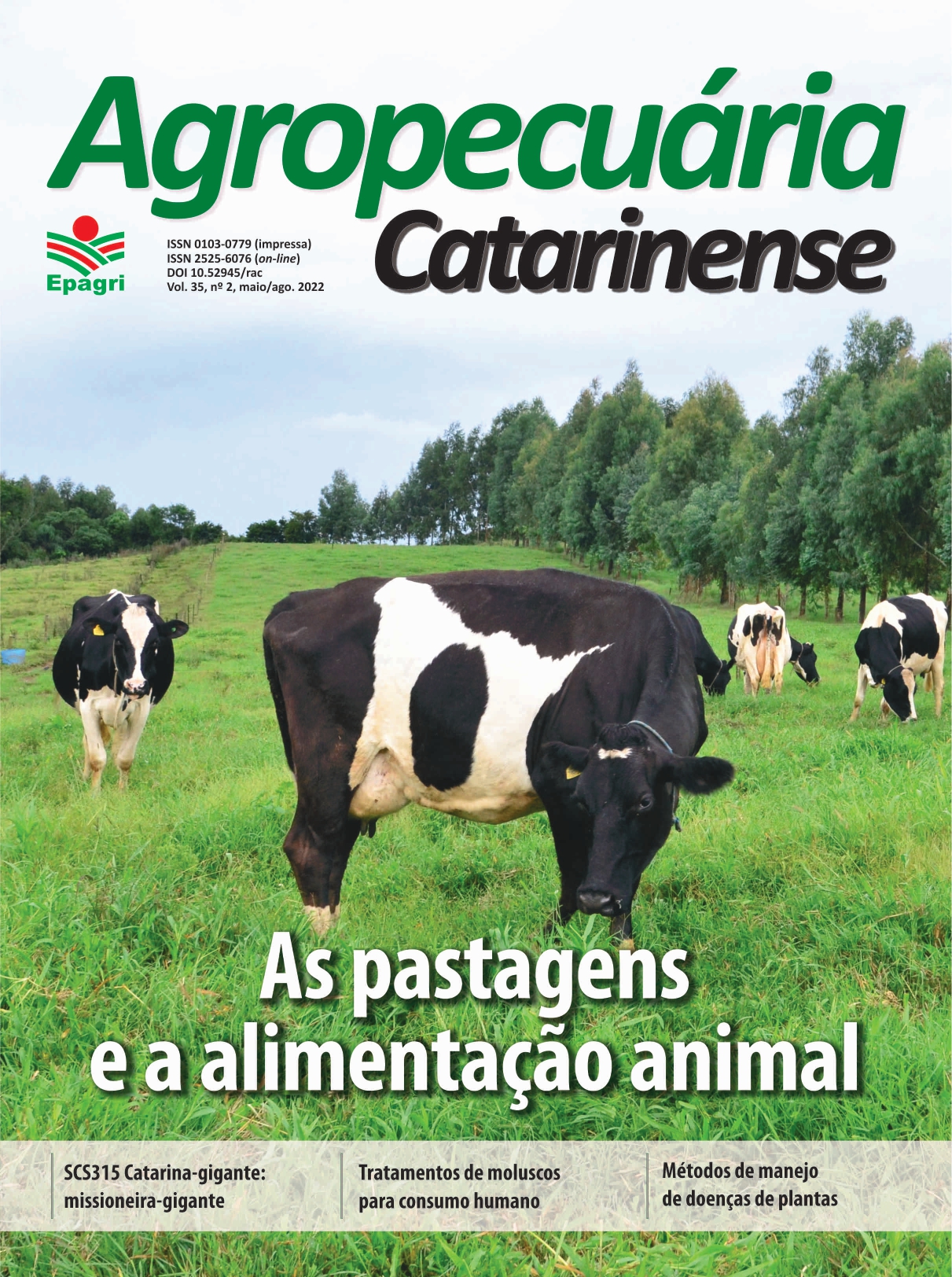Agroclimatc requirements for hop culture
DOI:
https://doi.org/10.52945/rac.v35i2.1273Keywords:
Humulus lupulus L, photoperiod, temperature, vernalization, degree-daysAbstract
Hops is a new species with interest for cultivation in Santa Catarina. There is little local information regarding its adaptation and performance in these climatic conditions. Despite being a plant originating from temperate climate and high latitudes, with cold winters and variable photoperiod throughout the year, cultivation experiences demonstrate the feasibility of cultivation of hop in warmer regions and lower latitudes. This fact demonstrates that some agroclimatic parameters, until now considered for the crop, are controversial. This study aims to discuss these parameters in light of the new knowledge
currently available.
Metrics
References
BAUERLE, W.L. Disentangling photoperiod from hop vernalization and dormancy for global production and speed breeding. Sci Rep. v.9, 16003, 2019. https://doi.org/10.1038/s41598-019-52548-0
BURGESS, A.H., Hops, botany, cultivation and utilization. ed. Polunin, N.
Interscience Publishers, New York ,1964.
CARRILHO, F. Necessidades do lúpulo do ponto de vista do clima e trabalhos
culturais. 1as Jornas Técnicas sobre a Cultura do Lúpulo, Braga. 1981.
CRAIN, M.N. Factors controlling hop flowering and their potential and their potential for use in the brewing and pharmaceutical industries. Honors Program Theses. 33p., 2011. https://scholarworks.uni.edu/hpt/10
DE CARVALHO, V.P. Zoneamento agroclimático da cultura de lúpulo para o estado do rio de janeiro: uma aplicação da lógica fuzzy. Dissertação (mestrado). UFRJ, 115p., 2018.
ERIKSEN, R.L.; RUTTO, L.K.; DOMBROWSKI, J.E.; HENNING, J.A. Photosynthetic Activity of Six Hop (Humulus lupulus L.) Cultivars under Different Temperature Treatments. HORTSCIENCE, v.55, n.4, p. 403-409, 2020.
DODDS, K. Hops, a guide for new growers. NSW Department of Primary Industries, 44 p., 2017.
FAGHERAZZI, M. M. Adaptabilidade de cultivares de lúpulo na região do planalto sul catarinense. Tese (Dourorado), UDESC, 118p., 2020.
HILTON, J.F. Farm Fresh Hops for six generation, 2002. Disponivel em:
Kralj D. Influence of temperature and rainfall on the growth of Savinja Golding. Proceedings of I Yugoslavian symposium of hop production, Velenje, Slovenia ; p. 7-20. 1962.
MAROVT, M.. Vpliv gostote in razporeditve rastlin na rast, razvoj in kakovost
hmelja (Humulus Lupulus L.) kultivarja 279D112. 2007. 51 p.. TCC (Graduação) -
Curso de Agronomijo, Univerza V Ljubljani, Ljubljana, 2007.
PAVLOVIČ, V., PAVLOVIČ, M.,ČERENAK, A., KOŠIR, I. J., ČEH, B., ROZMAN, TURK,
J., PAZEK, K., KROFTA, K., GREGORIC, G., Environment and weather influence on quality and Market value of hops, Plant Soil Environment, v. 58, p. 155-160, 2012.
RYBACEK, V. Hop Production, vol. 16. 1st edition. Holland: Elsevier Science. 286 p., 1991.
SPÓSITO, M.B. et al.. A cultura do lúpulo / -- Piracicaba: ESALQ Divisão de Biblioteca, 81 p., 2019 (Série Produtor Rural, no. 68).
SIRRINE, J.R. Sustainable Hoop Production in the Great Lakes Region. MSU Extention, 2009.
THOMAS, G.G., SCHWABE, W.W. Factors Controlling Flowering in the Hop (Humulus lupulus L.). Ann. Bot.v.33, p.781-793, 1969.
WAGNER T. Hmeljarstvo. 1. del – skripta. Kmetijski kombinat Žalec: 115 str.1968.
WAGNER T. Vpliv temperature in vlage na pridelek hmelja v Sloveniji. Hmeljarski
bilten, v.3, p. 81-88, 1975.
WILLIAMS, I.H.; ROBERTS, J.B.; COLEY‑SMITH, J.R. Studies of the dormant phase of the hop (Humulus lupulus L.) Annual report for 1960. Department of Hop Research, Wye College England, p. 48–58. 1961.
ZMRZLAK, M. Dynamics of phenological development of hops (cv. Savinjski Golding, Aurora) related to air temperature in lower Savinja valley. Graduation Thesis. Univerza v Ljubljani, Biotehniška fakulteta, Agronomija: p. 11-59. 1991.
ZMRZLAK M., KAJFEŽ-BOGATAJ L. Phenological modeling of growth stages of the hop (Humulus lupulus L.). Biometeorology, Proc. of the 14th Int. Con. of Biometeorology, Ljubljana, Slovenia, 1996.
Downloads
Published
How to Cite
Issue
Section
License
Copyright (c) 2022 Gabriel Berenhauser Leite, Cristina Pandolfo

This work is licensed under a Creative Commons Attribution 4.0 International License.



